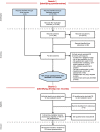Questionnaires in otology: a systematic mapping review
- PMID: 33879248
- PMCID: PMC8059288
- DOI: 10.1186/s13643-021-01659-9
Questionnaires in otology: a systematic mapping review
Abstract
Background: Patient-reported outcome measures (PROMs) are valuable tools in assessing the quality of health care from a patient perspective and are increasingly used by otologists. However, selecting the right questionnaire has proven to be a difficult and time-consuming task. To facilitate this process, we will provide a comprehensive overview of existing questionnaires.
Methods: A systematic literature search has been conducted on August 26, 2019, using the EMBASE and PubMed medical databases. 13,345 unique records were extracted. Questionnaires addressing any otologic complaint (tinnitus, hearing loss, earache, otorrhoea, and ear-related pressure sensation, vertigo, itch, or dysgeusia) were identified. All questionnaires were evaluated for eligibility by two independent researchers. Inclusion criteria were adult population, closed-ended questions, English language of the questionnaire, and the availability of the original article describing the development of the instrument or a validation paper describing the validation process written in English.
Objective: Create a comprehensive overview of all validated closed-ended otology questionnaires for adults and demonstrate their basic characteristics.
Main outcome measure: The number of questionnaires in English literature for the adult population, subdivided per symptom and target population.
Results: A total of 155 unique questionnaires were selected: 33 tinnitus questionnaires, 23 vertigo questionnaires, 84 hearing loss questionnaires, and 15 multiple complaint questionnaires. A protocol for further questionnaire comparison is presented.
Discussion: Two separate sequential searches were needed to identify unique questionnaires and to identify their development/validation paper. Although many ear diseases create multiple symptoms, the majority of the questionnaires were symptom specific.
Conclusion: Many questionnaires concerning ear-related symptoms exist and predominantly concern hearing loss, vertigo, or tinnitus. Only a few questionnaires cover the multiple complaints that ear diseases can create. The presented overview is the most comprehensive overview of otology questionnaires in literature to date. It will serve as a basis for questionnaire selection by professionals and could serve as a protocol for questionnaire selection in other fields.
Systematic review registration: PROSPERO CRD42017058155.
Keywords: Ear diseases; Otolaryngology; Patient-reported outcome measures (PROMs); Questionnaires.
Conflict of interest statement
The authors declare that they have no competing interests.
Figures

Similar articles
-
Signs and symptoms to determine if a patient presenting in primary care or hospital outpatient settings has COVID-19.Cochrane Database Syst Rev. 2022 May 20;5(5):CD013665. doi: 10.1002/14651858.CD013665.pub3. Cochrane Database Syst Rev. 2022. PMID: 35593186 Free PMC article.
-
Home treatment for mental health problems: a systematic review.Health Technol Assess. 2001;5(15):1-139. doi: 10.3310/hta5150. Health Technol Assess. 2001. PMID: 11532236
-
The clinical effectiveness and cost-effectiveness of enzyme replacement therapy for Gaucher's disease: a systematic review.Health Technol Assess. 2006 Jul;10(24):iii-iv, ix-136. doi: 10.3310/hta10240. Health Technol Assess. 2006. PMID: 16796930
-
A rapid and systematic review of the clinical effectiveness and cost-effectiveness of topotecan for ovarian cancer.Health Technol Assess. 2001;5(28):1-110. doi: 10.3310/hta5280. Health Technol Assess. 2001. PMID: 11701100
-
Ginkgo biloba for tinnitus.Cochrane Database Syst Rev. 2022 Nov 16;11(11):CD013514. doi: 10.1002/14651858.CD013514.pub2. Cochrane Database Syst Rev. 2022. PMID: 36383762 Free PMC article.
Cited by
-
Refinement and Validation of a New Patient-Reported Experience Measure for Hearing Loss (My Hearing PREM).Health Expect. 2025 Apr;28(2):e70225. doi: 10.1111/hex.70225. Health Expect. 2025. PMID: 40088002 Free PMC article.
-
Minimal Clinically Important Difference of Tinnitus Outcome Measurement Instruments-A Scoping Review.J Clin Med. 2023 Nov 15;12(22):7117. doi: 10.3390/jcm12227117. J Clin Med. 2023. PMID: 38002730 Free PMC article.
-
The International Standard Set of Outcome Measures for the Assessment of Hearing in People with Osteogenesis Imperfecta.Otol Neurotol. 2023 Aug 1;44(7):e449-e455. doi: 10.1097/MAO.0000000000003921. Epub 2023 Jun 16. Otol Neurotol. 2023. PMID: 37317476 Free PMC article.
-
Globally applicable solution to hearing loss screening: a diagnostic accuracy study of tablet-based audiometry.BMJ Open. 2025 May 22;15(5):e097550. doi: 10.1136/bmjopen-2024-097550. BMJ Open. 2025. PMID: 40404318 Free PMC article. Clinical Trial.
-
Cross-Cultural Translation and Adaptation of the Consumer Ear Disease Risk Assessment (CEDRA) Questionnaire in Danish.Audiol Res. 2023 Nov 2;13(6):859-870. doi: 10.3390/audiolres13060075. Audiol Res. 2023. PMID: 37987333 Free PMC article.
References
-
- De Vet HCW, Terwee CB, Mokkink LB, Knol DL. Measurement in medicine. Cambridge: Cambridge University Press; 2011.
-
- Bess FH, Lichtenstein MJ, Logan SA. Making hearing impairment functionally relevant: linkages with hearing disability and handicap. Acta Otolaryngol Suppl. 1990;476:226–231. - PubMed
Publication types
MeSH terms
LinkOut - more resources
Full Text Sources
Other Literature Sources
Medical
Research Materials

